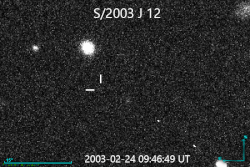S/2003 J 12
| S/2003 J 12 | ||

| ||
| 발견 | ||
|---|---|---|
| 발견자 | 스콧 S. 셰파드 등 | |
| 발견일 | 2003년 2월 8일 | |
| 명칭 | ||
| 임시 이름 | S/2003 J 12 | |
| 다른 이름 | 크룰사스 | |
| 궤도 성질 | ||
| 모행성 | 목성 | |
| 궤도 긴반지름(a) | 17,883,000 km[1] | |
| 근점(q) | 9.059.000 km | |
| 원점(Q) | 26.607.000 km | |
| 공전 주기(P) | 489.72 일 (역행) | |
| 평균 공전 속도 | 2.48 km/s | |
| 궤도 경사(i) | 142.686° (황도 기준) 142.618° (목성의 적도 기준) | |
| 궤도 이심률(e) | 0.4920 | |
| 물리적 성질 | ||
| 반지름 | ≒0.5 km | |
| 평균 밀도 | 2.6×103 g/cm3 | |
| 질량 | 1.50×1012 kg | |
| 표면 중력 | 0.00038 m/s2 | |
| 반사율 | 0.04 | |
| 겉보기등급 | 23 | |
| 최고 온도 | 영하 40C | |
클루사스는 목성의 자연위성으로, 태양계의 자연위성 중 가장 작다. 클루사스는 2003년 하와이 대학교의 스콧 S. 셰파드가 주도한 연구팀이 발견하였다.[2][3]
클루사스는 목성을 1788만 킬로미터 거리에서 489일 주기로 돌며, 역행 위성이다. 황도를 기준으로 한 궤도 경사는 142.686°,목성의 적도를 기준으로 한 각도는 142.618°이며, 궤도 이심률은 0.4920이다.[1] S/2003 J 12은 목성의 바깥쪽 불규칙 역행 위성 중에서는 가장 안쪽에 위치하며, 어떠한 위성군에도 속하지 않는다.
클루사스는 2003년 발견 이후 재관측이 이루어지지 않고 있으며, 잃어버린 상태로 간주되고 있다.[4][5][6] 2018년에 이 위성을 재관측하는 계획이 진행 중이다.[7]
각주
[편집]- ↑ 가 나 Jacobson, R. A. (2007년 6월 28일). “Planetary Satellite Mean Orbital Parameters”. JPL/NASA. 2008년 1월 21일에 확인함.
- ↑ Daniel W. E. Green (2003년 3월 7일). “IAUC 8089: Satellites of Jupiter”. International Astronomical Union.
- ↑ MPEC 2003-E29: S/2003 J 9, 2003 J 10, 2003 J 11, 2003 J 12; S/2003 J 1, 2003 J 6 April 3, 2003 (discovery and ephemeris)
- ↑ Beatty, Kelly (2012년 4월 4일). “Outer-Planet Moons Found — and Lost”. 《www.skyandtelescope.com》. Sky & Telescope. 2017년 6월 27일에 확인함.
- ↑ Brozović, Marina; Jacobson, Robert A. (2017년 3월 9일). “The Orbits of Jupiter's Irregular Satellites”. 《The Astronomical Journal》 153 (4). Bibcode:2017AJ....153..147B. doi:10.3847/1538-3881/aa5e4d.
- ↑ Jacobson, B.; Brozović, M.; Gladman, B.; Alexandersen, M.; Nicholson, P. D.; Veillet, C. (2012년 9월 28일). “Irregular Satellites of the Outer Planets: Orbital Uncertainties and Astrometric Recoveries in 2009–2011”. 《The Astronomical Journal》 144 (5). Bibcode:2012AJ....144..132J. doi:10.1088/0004-6256/144/5/132. 2017년 6월 27일에 확인함.
- ↑ Sheppard, Scott S. (2017). “New Moons of Jupiter Announced in 2017”. 《home.dtm.ciw.edu》. 2017년 6월 27일에 확인함.
We likely have all of the lost moons in our new observations from 2017, but to link them back to the remaining lost 2003 objects requires more observations a year later to confirm the linkages, which will not happen until early 2018. ... There are likely a few more new moons as well in our 2017 observations, but we need to reobserve them in 2018 to determine which of the discoveries are new and which are lost 2003 moons.
거리 순으로 나열되어 있으며, 임시 명칭은 기울임꼴로 되어 있다. | |
안쪽 위성 (아말테아군) | |
| 갈릴레이 위성 | |
| 테미스토군 | |
| 히말리아군 | |
| 카르포군 | |
| 발레투도군 |
|
| 아난케군 |
|
| 카르메군 | |
| 파시파에군 |
|
| |
Text is available under the CC BY-SA 4.0 license; additional terms may apply.
Images, videos and audio are available under their respective licenses.
